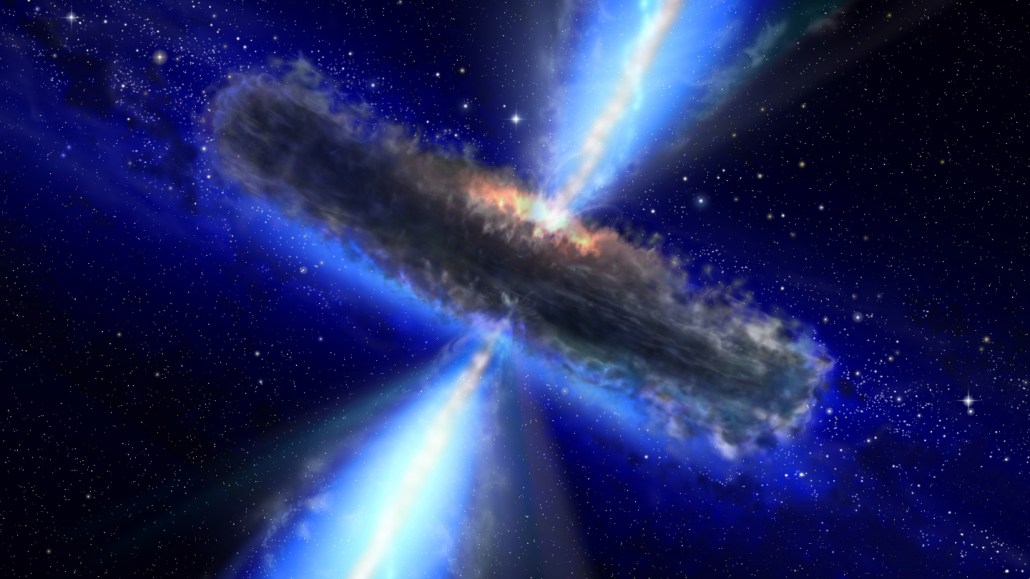
Some supermassive black holes go through a phase of rapid growth, forming an active galactic nucleus (illustrated) that can glow brighter than the surrounding galaxy.
ESA, NASA and Paolo Padovani/AVO project
- More than 2 years ago
Fewer supermassive black holes may undergo growth spurts than astronomers had suspected.
Every known large galaxy hosts a gargantuan black hole at its center. Some of those behemoths experience bursts of beefing up, during which time they blaze brightly. But recent observations from the James Webb Space Telescope turned up far fewer of these active black holes than expected, researchers report in a paper submitted August 22 at arXiv.org.
If confirmed, the finding raises questions about how some supermassive black holes got to be so big and what, if any, impact they have on the galaxies they inhabit.
Huge black holes, such as the one at the center of the Milky Way, tend to be pretty quiet (SN: 6/28/23). But occasionally, a surge of interstellar detritus rains down upon them — often following a collision with another galaxy — creating what’s called an active galactic nucleus, or AGN. Here, the heart of the host galaxy emits copious amounts of light at all wavelengths as the influx of material swirling around the black hole heats up. An AGN can not only outshine their host galaxies, but they are also the brightest persistent sources of light in the universe.
In 2017, astronomer Allison Kirkpatrick of the University of Kansas in Lawrence and colleagues predicted that JWST’s infrared eyes would find lots of these active black holes based on observations from other, less sensitive, space-based infrared telescopes. In the new study, Kirkpatrick and her team turned JWST toward a well-studied strip of sky where, in 2008, the Spitzer Space Telescope had found infrared signatures of active galactic nuclei in nearly a third of the 19 galaxies it studied.
Those galaxies, seen as they were around the peak of cosmic star formation roughly 10 billion years ago, were all relatively bright and massive. JWST is much more sensitive than Spitzer, so it’s capable of spotting fainter, more average-sized galaxies at the same epoch — ones more comparable in size to the Milky Way. And yet, out of the nearly 500 galaxies that JWST spotted, all observed for the first time, just 6 percent appear to contain active galactic nuclei, the team reports.
“We are actually probing a new population” of galaxies, says Tonima Tasnim Ananna, an astronomer at Wayne State University in Detroit, who was not involved with the study. The new data come from the far reaches of the universe, a region now more accessible than ever before thanks to JWST.
The new-to-us galaxies appear to be filled with interstellar dust. So it is possible, Kirkpatrick says, that fast-growing black holes are hiding in these distant dusty galaxies, and researchers just don’t have the technical capabilities to identify them yet.
If there really aren’t as many of these fast-growing black holes as once thought, it would throw astronomers’ understanding of black hole and galaxy formation for a loop. Supermassive black holes can weigh as much as several million — or even several billion — suns. The AGN phase is thought to be an important step for gathering so much mass.
“Maybe all galaxies don’t go through this active phase, [and] their black holes grow pretty slowly,” Kirkpatrick says. This would mean that some supermassive black holes would need to have started out relatively hefty, rather than growing up from comparably tiny objects.
And an active black hole doesn’t just grow quickly in isolation. It also affects its host galaxy. “It gets really, really hot” in an AGN, Kirkpatrick says. That can make it harder for the host galaxy to form stars, which need relatively cool gas to get started.
And the radiation pressure around a rapidly accreting supermassive black hole can be powerful enough to launch winds “like a trillion hurricanes just ripping through your galaxy,” Kirkpatrick says. These winds could, in turn, make things too unstable near the galaxy’s center for planets to form that are capable of sustaining life, she says. But if many black holes aren’t going through an AGN phase, they may not be influencing their host galaxies all that much.
Another explanation for the apparent dearth of active black holes in the new JWST data is that many supermassive black holes could grow up through periodic, short bursts of activity. In that case, they would have influenced the galaxy around them — but such bursts would be virtually undetectable.
If the black holes “just flicker on and off for short time periods,” Kirkpatrick says, “you’re never going to find these things. You’re never going to be able to understand how the black holes are growing.”
More answers could be coming soon: Kirkpatrick is planning to use JWST again in January to conduct an even larger search. Instead of the nearly 500 galaxies used in this study, she says, “I’m going to have probably 4,000 galaxies to look at now.”







